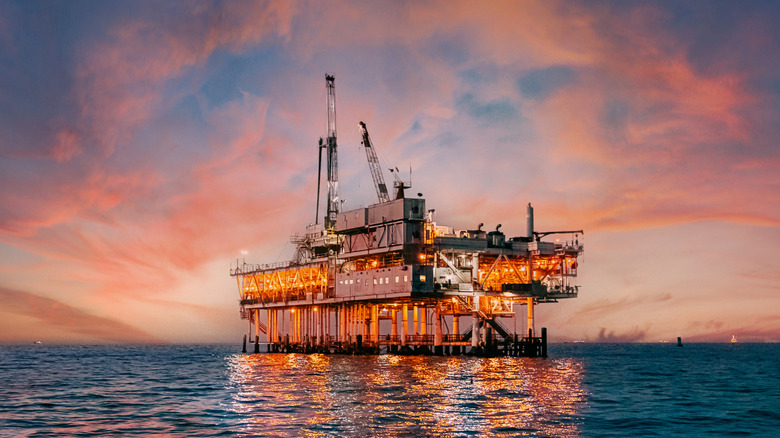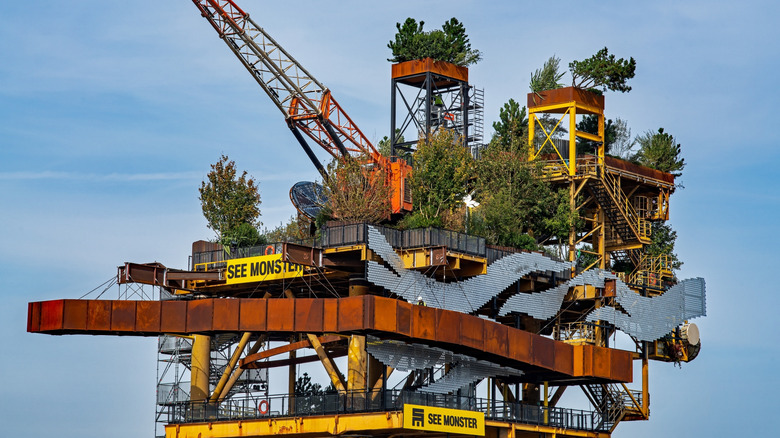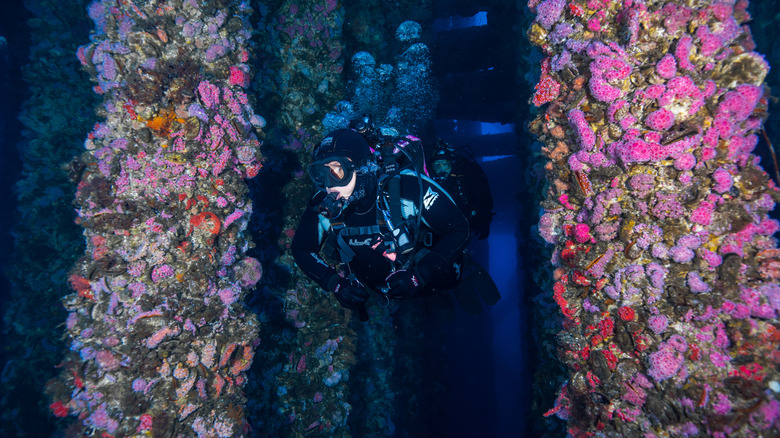What Happens To Offshore Oil Rigs When The Oil Runs Out?
An increasingly hot-button issue, oil rigs have become the physical embodiment of larger economic and environmental debates, garnering praise from conservative politicians and the ire of environmental activists. Oil rigs present several unique challenges for sustainable energy advocates. However, there is one under-discussed question — and it's not when the auto industry will stop using fossil fuels – which many warn may become a crisis in coming years: what happens when deep-sea oil rigs reach the end of their lifespan?
As it stands, roughly 12,000 offshore oil and gas rigs pepper the world's coastlines. These platforms typically operate for between 20 and 40 years. Industry experts believe that thousands of these wells will reach the end of their lifespan within the next ten years. According to a 2024 report by the academic journal Nature, roughly 1,500 platforms in the Gulf of Mexico have reached their 30th birthday, while the average age of the North Sea's 1,500 plus rigs is 25 years. An additional 2,500 in the Asia-Pacific region will need to be decommissioned by 2035.
Built to withstand extreme oceanic conditions and house hundreds of people at a time, the size, technical complexity, and location of oil rigs make dismantling them a massive task. The world's largest platform, the Berkut oil rig in the Russian Pacific, weighs about 200,000 tons. The Petronius, located 130 miles off the coast of New Orleans would be the fourth tallest building in the world at 2,001 feet.
Decommissioning an oil rig
Decommissioning an oil rig presents logistical, financial, and environmental problems. Once a well runs dry, companies must clear equipment, seal the well, and remove all infrastructure from the ocean floor. The most expensive stage is plugging the well, which entails cleaning it out and filling it with low-permeability materials, such as a cement mixture. This process carries exorbitant costs. Annual worldwide spending on decommissioning oil rigs is projected to reach $13 billion by 2045.
In 2023, Nature Energy reported that 14,000 inactive wells remained unplugged in the Gulf of Mexico, a problem with a solution carrying an estimated $30 billion price tag. This poses an acute issue for lawmakers, as states can be left to assume the responsibility of plugging derelict oil rigs. California learned this the hard way in 2017 when decommissioning Platform Holly, an oil rig located off the coast of Santa Barbara made famous as the source of a 450,000-gallon oil spill. The price of plugging the rig's wells — a whopping $360 million — bankrupted its operator, Venoco, who promptly abandoned the platform and forced the state to cover most of the decommissioning costs. Seven years after the state-funded decommissioning process began, the platform's 30 wells, which leaked highly toxic hydrogen sulfide, were finally plugged in September 2024.
Life after rigging
Traditionally, companies can either leave, bury, recycle, or repurpose decommissioned oil platforms. What happens to a decommissioned oil rig depends partly on its location. In the North Sea, for example, companies must completely remove decommissioned infrastructure. However, although originally instituted as a means of reducing their environmental impact, scientists have begun to question whether removing platforms does more harm than good. Some caution that rigs are de facto reefs critical to local ecosystems, and credited with reinvigorating endangered species like the bocaccio rockfish. One study found that a typical eight-legged platform can house 12,000 to 14,000 fish.
The U.S. Bureau of Safety and Environmental Enforcement has addressed this issue by converting over 600 platforms to artificial reef ecosystems through its Rigs-to-Reefs program. According to the bureau, reefing typically involves either towing the platform to a selected reef area, and placing the detached reef onto its side, or severing the platform roughly 85 feet below sea level and placing the detached platform top beside its base on the seabed. While converting decommissioned rigs to an artificial reef is popular, some scientists argue that the evidence behind it is mixed, with platforms attracting sea life from other locations while exposing marine ecosystems to harmful materials.
Industry professionals are increasingly looking to repurpose oil platforms. Several creative solutions have come to the fore in recent years, including converting them into offshore wind turbines, carbon capture facilities, and clean hydrogen plants. SpaceX and the U.S. Navy, have dabbled with converting oil rigs into rocket launchpads and missile defense systems, respectively. Rigs have even entered the arts and entertainment space, with platforms transformed into an art installation, museum, and even an amusement park.


